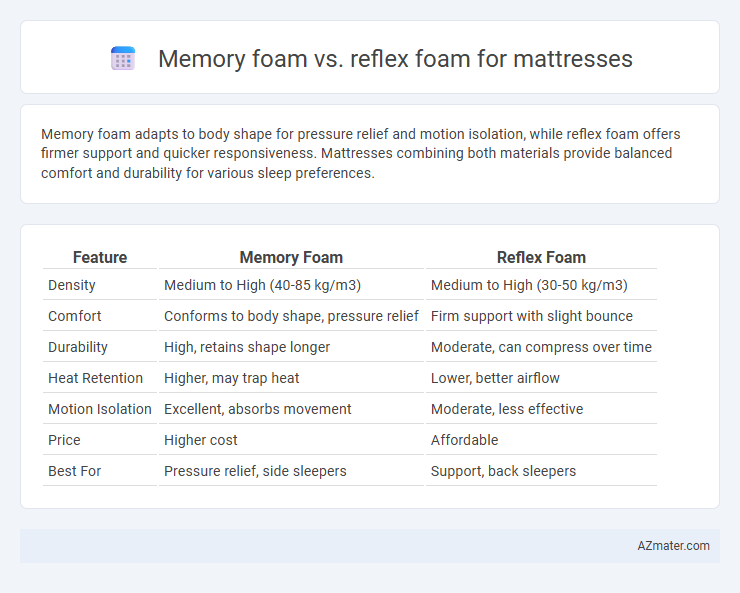Memory foam adapts to body shape for pressure relief and motion isolation, while reflex foam offers firmer support and quicker responsiveness. Mattresses combining both materials provide balanced comfort and durability for various sleep preferences.
Table of Comparison
| Feature | Memory Foam | Reflex Foam |
|---|---|---|
| Density | Medium to High (40-85 kg/m3) | Medium to High (30-50 kg/m3) |
| Comfort | Conforms to body shape, pressure relief | Firm support with slight bounce |
| Durability | High, retains shape longer | Moderate, can compress over time |
| Heat Retention | Higher, may trap heat | Lower, better airflow |
| Motion Isolation | Excellent, absorbs movement | Moderate, less effective |
| Price | Higher cost | Affordable |
| Best For | Pressure relief, side sleepers | Support, back sleepers |
Introduction to Memory Foam and Reflex Foam
Memory foam, developed by NASA in the 1960s, is a viscoelastic material known for its excellent pressure-relieving properties and ability to contour to the body's shape, providing personalized support and comfort. Reflex foam, often made from polyurethane, is a high-resilience foam that offers firmer support with quicker responsiveness and greater durability, making it ideal for those who prefer a bouncier mattress feel. Understanding the fundamental differences between memory foam's slow response and contouring capabilities versus reflex foam's firm, supportive nature is essential for selecting the best mattress type for individual sleep preferences.
Key Differences Between Memory Foam and Reflex Foam
Memory foam molds to the body's shape, providing contouring support and pressure relief, while reflex foam offers higher resilience and bounce due to its open-cell structure. Memory foam typically responds slower to pressure, enhancing motion isolation, whereas reflex foam quickly regains its shape and promotes better air circulation for temperature regulation. Durability varies as memory foam can soften over time, but reflex foam maintains consistent firmness and structural integrity, making it ideal for users requiring both comfort and support.
Comfort and Support: Memory Foam vs Reflex Foam
Memory foam contours to the body, providing pressure relief and personalized comfort by evenly distributing weight, ideal for side and back sleepers. Reflex foam offers firmer support with quicker responsiveness and durability, maintaining spinal alignment and preventing sagging over time. Both foams contribute significantly to mattress comfort and support, but memory foam excels in cushioning, while reflex foam prioritizes structural resilience.
Durability and Longevity Comparison
Memory foam mattresses typically offer superior durability due to their dense, viscoelastic structure that resists sagging and maintains shape over time. Reflex foam, while more resilient and springier, tends to degrade faster under prolonged pressure, leading to reduced longevity compared to high-density memory foam. Both materials vary in lifespan based on quality and usage, but memory foam generally provides longer-lasting comfort and support for mattress applications.
Temperature Regulation and Breathability
Memory foam mattresses offer superior pressure relief with their body-contouring properties but tend to retain heat due to their dense structure, which can reduce breathability and cause discomfort during warmer nights. Reflex foam, also known as polyurethane foam, is more breathable thanks to its open-cell structure, allowing better air circulation and improved temperature regulation. For individuals who sleep hot or require enhanced airflow, reflex foam mattresses provide a cooler sleeping surface compared to memory foam options.
Pressure Relief and Spine Alignment
Memory foam mattress excels in pressure relief by contouring to the body's curves, evenly distributing weight, and minimizing pressure points, which supports proper spine alignment. Reflex foam offers firmer support with quicker response to movement, providing stability but less contouring, which may result in uneven pressure distribution and less optimal spine posture for side sleepers. For individuals prioritizing pressure relief and spinal alignment, memory foam is generally more effective in maintaining a neutral spine position and reducing discomfort during sleep.
Allergy and Hypoallergenic Properties
Memory foam is naturally resistant to dust mites and allergens due to its dense structure, making it a hypoallergenic choice for individuals prone to allergies. Reflex foam, while durable and supportive, has an open-cell structure that can trap dust and allergens more easily, potentially aggravating allergy symptoms. For allergy sufferers, memory foam mattresses offer superior protection against common triggers like dust mites and mold, promoting a cleaner sleep environment.
Price Comparison: Which Offers Better Value?
Memory foam mattresses typically cost more due to advanced materials and pressure-relieving properties, ranging from $800 to $2,000. Reflex foam mattresses are more budget-friendly, usually priced between $300 and $800, offering firmer support but less contouring comfort. Considering durability and comfort, memory foam provides better long-term value despite the higher upfront cost.
Suitability for Different Sleepers
Memory foam adapts closely to body contours, making it ideal for side sleepers who need pressure relief on shoulders and hips. Reflex foam offers a firmer, more responsive surface that suits back and stomach sleepers seeking enhanced spinal alignment and support. Combination sleepers benefit from memory foam's adaptability, while those preferring a bounce or quicker recovery may favor reflex foam for its durability and resilience.
Choosing the Right Foam Mattress for You
Memory foam mattresses conform closely to the body's shape, providing superior pressure relief and motion isolation, ideal for side sleepers and individuals with joint pain. Reflex foam, also known as high-resilience foam, offers greater support and durability, making it suitable for those who prefer a firmer mattress or need enhanced spinal alignment. Selecting the right foam mattress depends on your sleeping position, comfort preference, and any specific orthopedic requirements.

Infographic: Memory foam vs Reflex foam for Mattress
 azmater.com
azmater.com